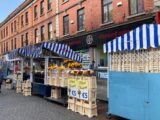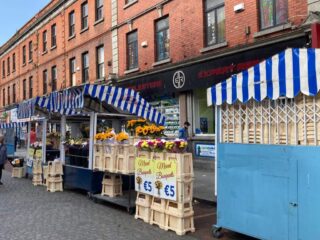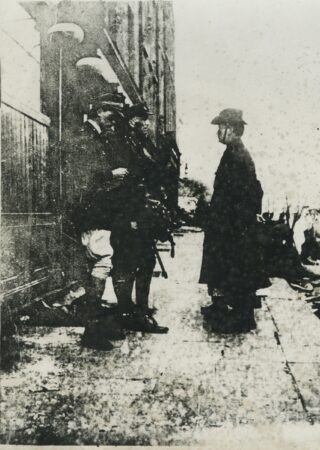Notice
14 – 17 Moore Street are state-owned National Monuments in the care of the Office of Public Works
WARNING: It should be noted that these sites are unguided and a level of care and caution should be maintained during all stages of your visit. The Office Of Public Works (OPW) will not be held responsible for any damages, injuries, or losses that occur
Moore Street (no. 14 – 17)
It is impossible to think of Moore Street and not think of the 1916 Easter Rising. The rebellion and these 18th century houses are synonymous with each other in recent history.
These terraced, three storey houses were built around 1760 and had their front facades restored around 1900. Currently, conservation and repair works are taking place in order to turn these 4 houses into a commemorative centre. During these current works, excavations took place and approximately 4000 artefacts were discovered under the floorboards. Items such as match-boxes and sewing paraphernalia were found, indicating a small factory or industry of some sort. Other items include jewellery and a pamphlet with images of Robert Emmet and Edward Fitzgerald.
After the GPO headquarters had to be evacuated during the rebellion, they escaped to the houses on Moore Street, which became their new impromptu headquarters.
It is recognised that it was at no. 16 Moore Street that the decision to surrender was agreed. Pearse wrote: ‘In order to prevent further slaughter of the civil population and in the hope of saving the lives of our followers, the members of the Provisional Government present at headquarters have decided on an unconditional surrender.’
It is said that this decision came about because Pearse saw a family being shot at by British soldiers as he looked out the window of no. 16 and watched as the father was killed. The O’Rahilly was also shot as he tried to escape from the burning GPO, and slowly bled to death over a day in a doorway on Moore Lane.
The famous photograph of Pádraig Pearse and Elizabeth O’Farrell issuing the surrender notice to General Lowe and his son was taken at the top of Moore Street.
Visit Historic Environment Viewer for more information on 14 – 17 Moore Street
Protect our Past - Click here to read about the importance of protecting our country’s unique heritage sites
This national monument is protected in accordance with the National Monuments Acts 1930 to 2014
Gallery
Nearby sites to visit
Garden of Remembrance
A tranquil memorial in the heart of Dublin city
Approx. 0.4 km from Moore Street (no. 14 – 17)
St. Mary’s Abbey – Chapter House – Cistercian Monastery
The ruins of one of the largest and most important monasteries in medieval Ireland
Approx. 0.5 km from Moore Street (no. 14 – 17)
Custom House Visitor Centre
Ireland’s best-known architectural marvel
Approx. 0.7 km from Moore Street (no. 14 – 17)
Dublin Castle
The nerve centre of historical power in Ireland
Approx. 0.9 km from Moore Street (no. 14 – 17)
St Audoen’s Church and Visitor Centre
A medieval chapel at the centre of city life
Approx. 1.0 km from Moore Street (no. 14 – 17)
St Stephen’s Green
A Victorian civic gem in Dublin’s greatest garden square
Approx. 1.2 km from Moore Street (no. 14 – 17)



